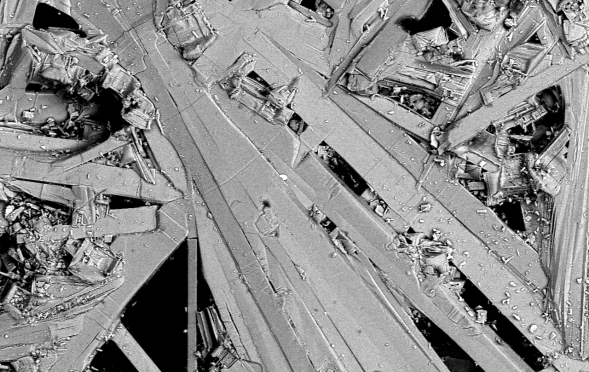Defect of the Month
Back to AGR's Library
When allowed to cool at a slow rate, molten glass can crystallize into minerals in a process known as devitrification. In most cases, devitrification is a problem for glass furnaces because it is a sign of cool spots or inadequate mixing. There are two devitrification products in this polarized light micrograph: the globules are composed of cristobalite (SiO2), while the fuzzy fringe is composed of devitrite (Na2O·3CaO·6SiO2). Tribbles, of course, are the cute but prolific alien creatures from Star Trek. The balls of cristobalite dendrites scattered across this sample resemble tribbles’ hairy, spherical bodies.

These long columnar crystals are composed of manmade vanadium oxide (V2O5) crystals, known as Shcherbinaite when found in nature. While not technically a defect itself, this particular sample is used as a standard for quantitative analysis of vanadium-containing metals. Almost any trip to the hardware store can uncover a plethora of chrome vanadium hand tools, such as hammers, wrenches, or knives. Glass products can be damaged by similar metallic objects, leaving behind residues on the glass surface. Using standards like this one, we can match the composition of the residue to a particular alloy or the suspected metal object itself.

This “fish-faced” stone is actually a conglomerate of very small quartz grains that are being converted into laths of tridymite. The uniform size of the grains and the large tridymite laths suggest that the stone originated from a silica refractory, most commonly found in the crown of a furnace. When viewed in polarized light, the different minerals take on vibrant rainbow hues. The overall shape bears an uncanny resemblance to the Clown Triggerfish, an animal found swimming among coral reefs in the Indian Ocean.

These snowflakes are actually crystals created by the erosion of zirconium-containing refractories in the furnace. The zirconium-enriched areas are not very soluble in the surrounding glass, so they tend to recrystallize into zirconia dendrites. The word “dendrite” itself comes from the Greek word for trees, Dendron, and aptly describes the appearance of these conifer-shaped crystals.
Pagination
- Previous page
- Page 24
- Next page